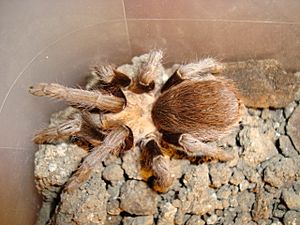Texas brown tarantula facts for kids
Quick facts for kids Texas brown tarantula |
|
|---|---|
 |
|
| Scientific classification | |
| Synonyms | |
|
The Texas brown tarantula is a common type of tarantula found in the Southern United States. It's also known as the Oklahoma brown tarantula or Missouri tarantula. Its scientific name is Aphonopelma hentzi.
These tarantulas can get quite big! Their legs can spread out more than 4 inches (10 cm). Adult Texas brown tarantulas can weigh over 3 ounces. Their bodies are usually dark brown, but the exact shade can be different for each spider. After they shed their skin (a process called a molt), their colors often look much brighter.
Contents
Life Cycle of the Texas Brown Tarantula
Female Texas brown tarantulas can lay many eggs, sometimes up to 1,000 at once! They place these eggs safely inside a web that looks like a hammock. This egg sac stays in her underground home, and she guards it carefully.
The eggs usually hatch in about 45 to 60 days. Once the baby spiders, called spiderlings, come out of the egg sac, they often stay with their mother for a few days. After that, they leave to dig their own burrows.
How Long Do Texas Brown Tarantulas Live?
Female Texas brown tarantulas are known to live for a very long time, sometimes up to 40 years! Scientists are still studying them, so they might even live longer than that. Male tarantulas, however, have a much shorter life. They usually live for only about a year after they become adults.
How Texas Brown Tarantulas Defend Themselves
The Texas brown tarantula is generally a calm and peaceful spider. It usually doesn't try to bite unless it feels very threatened.
Defense Moves
When a Texas brown tarantula feels bothered, it will stand up on its back legs. It then raises its front legs in a way that looks like a warning. This is a common defense move for many tarantulas.
Urticating Hairs
Like most tarantulas found in North and South America, the Texas brown tarantula has tiny, stiff hairs on its belly. These are called urticating hairs. If the tarantula feels in danger, it can kick these hairs towards whatever is bothering it. These hairs can be irritating if they get on skin or in eyes.
Predators
One of the main animals that hunts the Texas brown tarantula is a large wasp called the tarantula hawk (Pepsis grossa). These wasps are known for their powerful sting, which they use to paralyze tarantulas.
Are Their Bites Dangerous to Humans?
A bite from a Texas brown tarantula is usually not very harmful to people. The biggest concern is if someone has an allergic reaction to the bite. Because their fangs are large, the bite can cause a painful puncture wound. It's important to clean the wound well to prevent a secondary infection.
Where Do Texas Brown Tarantulas Live?
You can find the Texas brown tarantula in many parts of the United States. They live in states like Colorado, Kansas, Missouri, New Mexico, Oklahoma, Arkansas, Texas, and Louisiana. They have also been seen in the northern areas of Mexico, especially near the borders of New Mexico and Texas.
What Kind of Home Do They Like?
Texas brown tarantulas live on the ground. They often make their homes in grasslands. They dig burrows underground, or sometimes they use old logs, stones, or empty dens made by other small animals.
These tarantulas use their spinnerets to create silk webbing. They line the entrance of their homes with this webbing. This helps them feel when prey, like insects, walks by.
Images for kids
See also
 In Spanish: Tarántula marrón de Texas para niños
In Spanish: Tarántula marrón de Texas para niños


